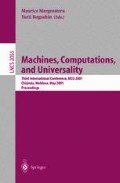Abstract
We present a biological computing paradigm that is based on genetic regulatory networks. Using a model of gene expression by piecewise linear differential equations we show that the evolution of protein concentrations in a cell can be considered as a process of computation. This is demonstrated by showing that this model can simulate memory bounded Turing machines. The simulation is robust with respect to perturbations of the system, an important property for both analog computers and biological systems.
Access this chapter
Tax calculation will be finalised at checkout
Purchases are for personal use only
Preview
Unable to display preview. Download preview PDF.
References
M.A. Nielsen and I.L. Chuang. Quantum Computation and Quantum Information. Cambridge University Press, 2000.
L. Kari. DNA computing: the arrival of biological mathematics. The mathematical intelligencer, 19(2):24–40, 1997.
J. Hertz, A. Krogh, and R. Palmer. Introduction to the Theory of Neural Computation. Addison-Wesley, Redwood City, 1991.
C. Mead. Analog VLSI and Neural Systems. Addison-Wesley, 1989.
H. Lodish, A. Berk, S.L. Zipursky, P. Matsudaira, D. Baltimore, and J. Darnell. Molecular cell biology. W.H. Freemand and Company, 4th edition, 2000.
S.A. Kauffman. Metabolic stability and epigenesis in randomly connected nets. Journal of Theoretical Biology, 22:437, 1969.
D. Bray. Protein molecules as computational elements in living cells. Nature, 376:307–312, July 1995. Computation in Gene Networks 23
H.H. McAdams and A. Arkin. Simulation of prokaryotic genetic circuits. Annual Review of Biophysics and Biomolecular Structure, 27:199–224, 1998.
T.S. Gardner, C.R. Cantor, and J.J. Collins. Construction of a genetic toggle switch in E. coli. Nature, 403:339–342, January 2000.
M.B. Elowitz and S. Leibler. A synthetic oscillatory network of transcriptional regulators. Nature, 403:335–338, January 2000.
A. Arkin and J. Ross. Computational functions in biochemical reaction networks. Biophysical Journal, 67:560–578, 1994.
T. Mestl, E. Plahte, and S.W. Omholt. A mathematical framework for describing and analyzing gene regulatory networks. Journal of Theoretical Biology, 176:291–300, 1995.
L. Glass. Combinatorial and topological method in chemical kinetics. Journal of Chemical Physics, 63:1325–1335, 1975.
C. Papadimitriou. Computational Complexity. Addison-Wesley, Reading, Mass., 1995.
H.T. Siegelmann. Neural Networks and Analog Computation: Beyond the Turing Limit. Birkhauser, Boston, 1999.
H.T. Siegelmann, A. Roitershtein, and A. Ben-Hur. Noisy neural networks and generalizations. In Proceedings of the Annual Conference on Neural Information Processing Systems 1999 (NIPS*99). MIT Press, 2000.
W. Maass and P. Orponen. On the effect of analog noise in discrete time computation. Neural Computation, 10(5):1071–1095, 1998.
L.F. Landweber and L. Kari. The evolution of cellular computing: nature’s solution to a computational problem. In Proceedings of the 4th DIMACS meeting on DNA based computers, pages 3–15, 1998.
L. Glass and J.S. Pasternack. Stable oscillations in mathematical models of biological control systems. Journal of Mathematical Biology, 6:207–223, 1978.
R.N. Tchuraev. A new method fo rthe analysis of the dynamics of the molecular genetic control systems. I. description of the method of generalized threshold models. Journal of Theoretical Biology, 151:71–87, 1991.
T. Mestl, R.J. Bagley, and L. Glass. Common chaos in arbitrarily complex feedback networks. Physical Review Letters, 79(4):653–656, 1997.
L. Glass and C. Hill. Ordered and disordered dynamics in random networks. Europhysics Letters, 41(6):599–604, 1998.
M.S. Branicky. Analog computation with continuous ODEs. In Proceedings of the IEEE Workshop on Physics and Computation, pages 265–274, Dallas, TX, 1994.
E. Asarin, O. Maler, and A. Pnueli. Reachability analysis of dynamical systems with piecewise-constant derivatives. Theoretical Computer Science, 138:35–66, 1995.
A. Saito and K. Kaneko. Geometry of undecidable systems. Prog. Theor. Phys., 99:885–890, 1998.
J.E. Hopcroft and J.D. Ullman. Introduction to Automata Theory, Languages, and Computation. Addison-Wesley, 1979.
P. Koiran and C. Moore. Closed-form analytic maps in one and two dimensions can simulate universal Turing machines. Theoretical Computer Science, 210:217–223, 1999.
J.E. Lewis and L. Glass. Nonlinear dynamics and symbolic dynamics of neural networks. Neural Computation, 4:621–642, 1992.
P. Orponen. The computational power of discrete hopfield nets with hidden units. Neural Computation, 8:403–415, 1996.
P. Orponen. Computing with truly asynchronous threshold logic networks. Theoretical Computer Science, 174:97–121, 1997.
C. Moore. Generalized one-sided shifts and maps of the interval. Nonlinearity, 4:727–745, 1991.
J.P. Crutchfield and K. Young. Computation at the onset of chaos. In W.H. Zurek, editor, Complexity, Entropy and the Physics of Information, pages 223–269, Redwood City, CA, 1990. Addison-Wesley.
C. Moore. Queues, stacks, and transcendentality at the transition to chaos. Physica D, 135:24–40, 2000.
R. Edwards, H.T. Siegelmann, K. Aziza, and L. Glass. Symbolic dynamics and computation in model gene networks. in preparation.
J. Sima and P. Orponen. A continuous-time hopfield net simulation of discrete neural networks. Technical Report 773, Academy of Sciences of the Czech Republic, 1999.
Author information
Authors and Affiliations
Editor information
Editors and Affiliations
Rights and permissions
Copyright information
© 2001 Springer-Verlag Berlin Heidelberg
About this paper
Cite this paper
Ben-Hur, A., Siegelmann, H.T. (2001). Computation in Gene Networks. In: Margenstern, M., Rogozhin, Y. (eds) Machines, Computations, and Universality. MCU 2001. Lecture Notes in Computer Science, vol 2055. Springer, Berlin, Heidelberg. https://doi.org/10.1007/3-540-45132-3_2
Download citation
DOI: https://doi.org/10.1007/3-540-45132-3_2
Published:
Publisher Name: Springer, Berlin, Heidelberg
Print ISBN: 978-3-540-42121-4
Online ISBN: 978-3-540-45132-7
eBook Packages: Springer Book Archive

